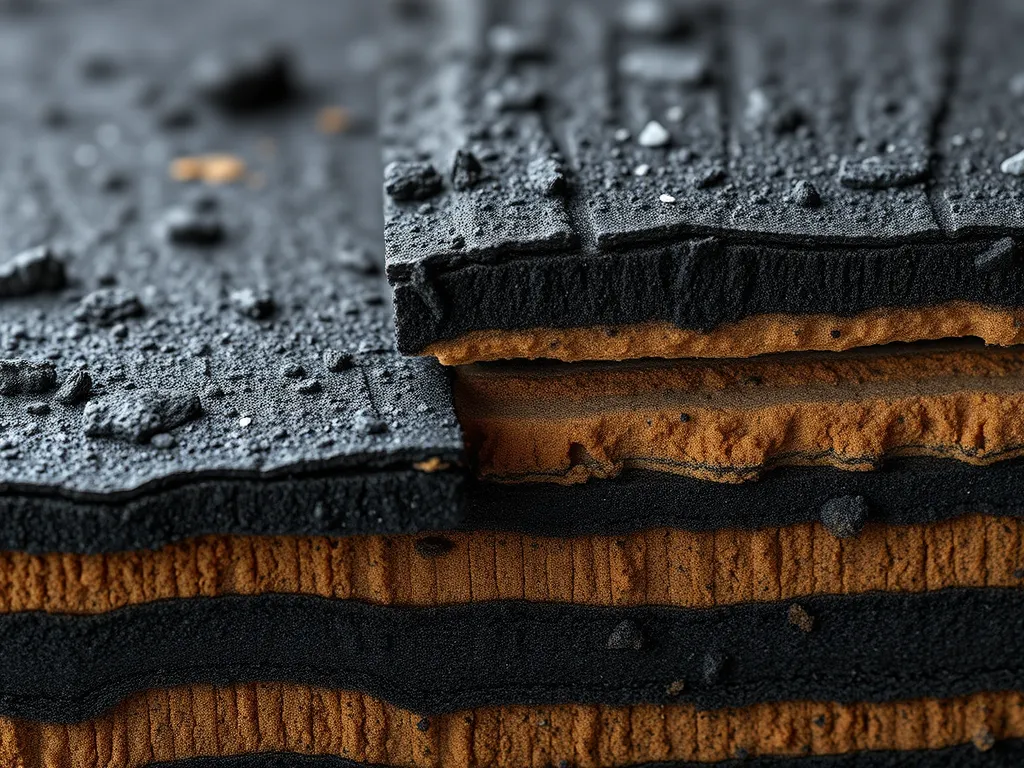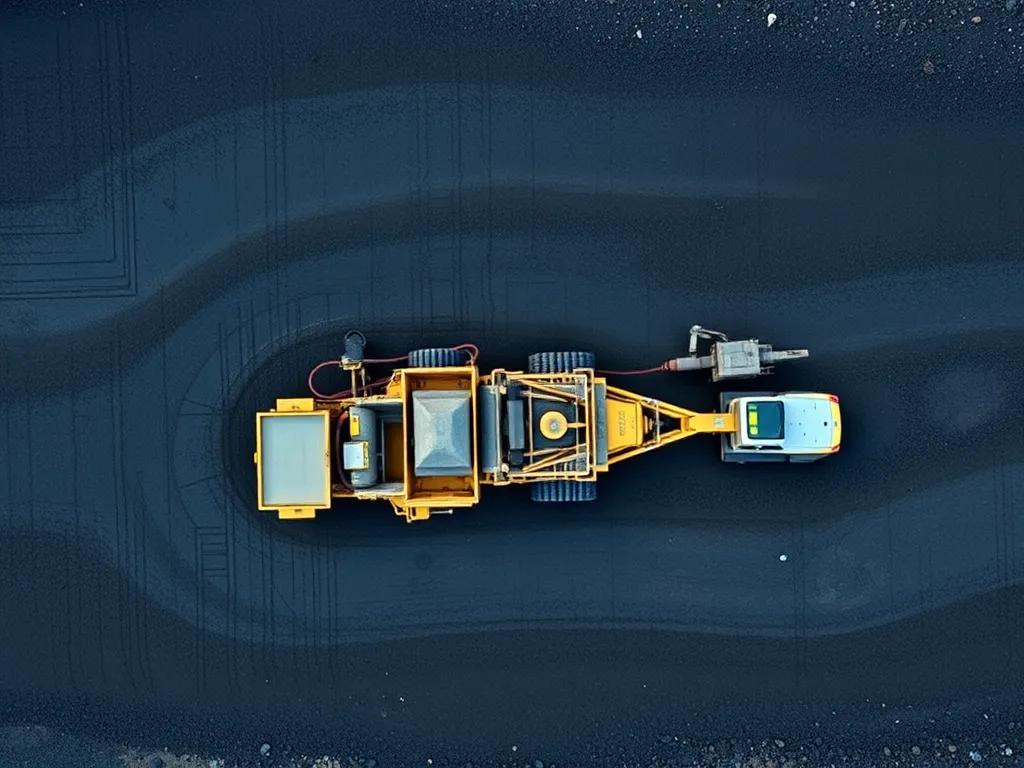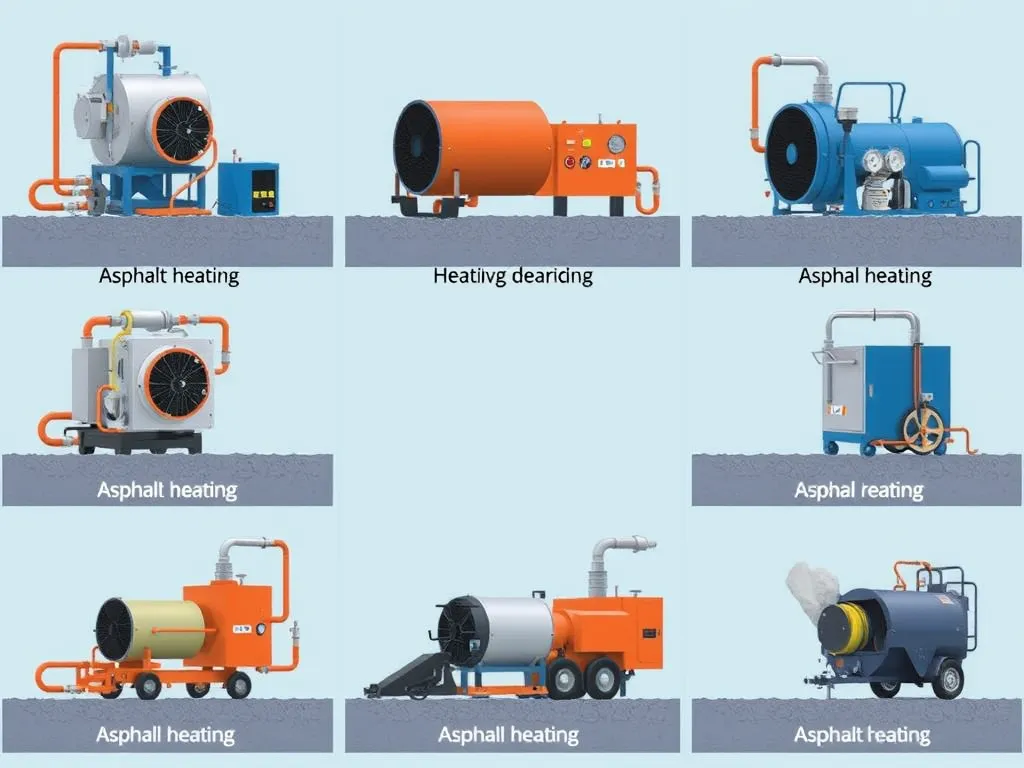Bitumen: The Sticky Science Behind Smooth Road Surfaces
Published on: September 20, 2025 | Last Updated: April 14, 2025
Written By: George Voss
Bitumen is the black, glue-like substance that binds asphalt road surfaces together. Derived from crude oil, this viscous material coats and holds aggregates like crushed stone and sand in asphalt mixes. Unlike asphalt (which combines bitumen with minerals), pure bitumen acts as both a waterproof shield and flexible binder. It resists cracking under traffic while preventing water damage. Common types include penetration-grade bitumen for standard roads and polymer-modified versions for heavy-duty use.
This article breaks down how bitumen works in pavement layers, its critical physical properties like viscosity and temperature tolerance, and why it outperforms alternatives. You’ll learn about emulsion applications for pothole repairs, recycled asphalt-bitumen mixes cutting costs by 20-30%, and how polymer additives extend road lifespans to 15+ years. We’ll also explore environmental impacts and compare bitumen to concrete in highway projects.
Contents
- What is Bitumen?
- Why Bitumen is Used in Asphalt Road Surfaces
- Key Properties Of Bitumen for Road Construction
- Types Of Bitumen Used in Asphalt Road Surfaces
- Bitumen Applications in Asphalt Road Layers
- Constructing Roads With Bitumen and Asphalt
- Advantages Of Bitumen in Asphalt Roadways
- Environmental Considerations
- Frequently Asked Questions
- Closing Thoughts
- Additional Resources for You:
What is Bitumen?
Bitumen forms the glue in road surfaces. This black, sticky stuff comes from crude oil. It binds stones and sand in asphalt mixes.
Definition and Basic Properties Of Bitumen
Bitumen is a semi-solid hydrocarbon. Key traits include:
- Waterproof – blocks moisture from road layers
- High viscosity – flows when heated, hardens when cool
- Adhesion – sticks to stones and gravel
- Flex – bends under heavy trucks without cracking
Penetration grade (like PEN 60-70) measures hardness. Lower numbers mean harder bitumen for hot climates.
Bitumen Vs. Asphalt: Clarifying Terminology
Asphalt mixes contain 5% bitumen and 95% crushed rock. Bitumen acts as the glue. Asphalt is the full blend used for paving. Terms often mix up:
- Bitumen road surface layer = top coat with bitumen-rich mix
- Bituminous surfacing = any road layer using bitumen binder
- Tar (rare now) = old coal-based binder, not used since the 1970s
Think of bitumen like butter in cookie dough – vital but not the whole treat.
These traits make bitumen a top pick for roads. Next, let’s break down why it beats other binders.
Why Bitumen is Used in Asphalt Road Surfaces
Bitumen forms the backbone of durable road networks. This petroleum-based binder serves multiple critical roles, from binding materials to adapting to environmental stress. Let’s break down its core functions.
Binding Aggregates in Asphalt Mixes
Bitumen acts as glue in asphalt mixes. When heated to 300°F, it coats crushed stone, sand, and gravel. This creates a uniform matrix that hardens into a solid layer. Typical mixes contain 4-8% bitumen by weight. Without this binder, aggregates would scatter under traffic, leading to rapid road failure.
- Adheres to angular aggregates for maximum grip
- Maintains structural integrity for 15-20 years
- Works with recycled asphalt pavement (RAP) up to 30% content
Waterproofing and Weather Resistance
Bitumen’s hydrophobic nature blocks water penetration. Roads face 50+ freeze-thaw cycles yearly in cold climates. Without waterproofing, moisture would erode base layers, causing potholes. Bitumen surfacing reduces cracking by 40% compared to untreated surfaces. It also resists UV oxidation, maintaining flexibility even at 160°F summer temperatures.
Flexibility Under Traffic Loads
Bitumen bends rather than breaks. A 6-inch thick bitumen road surface layer can handle 10,000+ daily vehicle passes. The binder’s viscoelastic properties let it rebound after heavy truck loads. PG (Performance-Graded) specifications like PG 64-22 ensure optimal stiffness at local temperature ranges. Roads with polymer-modified bitumen show 60% less rutting than rigid alternatives.
From highways to bitumen footpath construction, this material adapts to demands. Next, we’ll explore how specific properties make bitumen road surfaces outperform alternatives.

Key Properties Of Bitumen for Road Construction
Bitumen’s performance in road surfaces stems from three core traits. These traits ensure roads handle heavy loads, resist wear, and last over time.
Physical Properties: Viscosity and Penetration Grade
Viscosity defines how bitumen flows when heated. High viscosity bitumen (like PEN 60/70) resists deforming under summer heat. Penetration grade tests hardness by measuring how deep a needle sinks into bitumen under a 100g load. Roads in cold zones use softer grades (PEN 80/100) to prevent cracks. Hot climates need harder grades (PEN 40/50) to avoid rutting.
Chemical Stability in Asphalt Layers
Bitumen resists water, salts, and fuel spills. Its carbon-rich makeup stops oxidation, which can make asphalt brittle. Stable bitumen binds aggregates for 15-20 years without breaking down. Tests like the rolling thin film oven (RTFO) simulate aging to ensure chemical durability. This stops “stripping” – when water pushes bitumen off aggregates.
Temperature Sensitivity and Durability
Bitumen softens at 140°F and hardens below 40°F. Performance-grade (PG) binders like PG 64-22 handle specific temperature ranges. Roads in Arizona may use PG 70-10, while Minnesota roads need PG 58-28. Wrong grades cause thermal cracks or rutting. Properly graded bitumen lasts 10-15 years under daily traffic.
These traits shape how engineers pick bitumen for roads. Next, we break down the types of bitumen used to meet these needs.
Also See: Common Uses for Asphalt in Residential and Commercial Settings
Types Of Bitumen Used in Asphalt Road Surfaces
Bitumen’s versatility stems from its multiple formulations, each designed for specific road-building needs. Four primary types dominate modern construction.
Penetration Grade Bitumen
Classified by its hardness under standardized needle tests, penetration grade bitumen (PG) is specified by depth measurements in tenths of millimeters. PG 60/70 – which penetrates 60-70 dmm – remains the go-to choice for most climates. It binds aggregates in base layers while resisting rutting up to 140°F. High-traffic motorways frequently use PG 76-22 for boosted high-temp performance.
| Grade | Penetration (dmm) | Softening Point (°C) | Use Case |
|---|---|---|---|
| PG 40/50 | 40-50 | 52-60 | Cold regions |
| PG 60/70 | 60-70 | 49-56 | Temperate zones |
| PG 80/100 | 80-100 | 45-52 | Low-speed roads |
Bitumen Emulsions for Surface Treatments
These water-based blends contain 60-70% bitumen suspended with emulsifiers like soap. CSS-1h emulsions bond chippings in chip seals, while RS-2 types seal cracks without heat. Setting times vary: rapid-setting (RS) emulsions cure within 2 hours, making them ideal for high-traffic repairs. Emulsions cut energy use by 35% versus hot-mix methods.
Polymer-modified Bitumen (PMB)
By mixing styrene-butadiene-styrene (SBS) or ethylene-vinyl acetate (EVA) polymers into bitumen, PMB boosts elasticity by 300%. This prevents cracking in freezing temps below 14°F while maintaining stability above 176°F. PMB costs 20-30% more than standard grades but extends pavement life by 7-12 years. It’s mandated for busy intersections under AASHTO M 332 standards.
Viscosity-graded and Oxidized Bitumen
Viscosity-graded (VG) bitumen, like VG-30 or VG-40, is chosen based on flow resistance at 140°F. VG-40 handles 10,000+ daily truck loads on port roads. Oxidized bitumen – created by blowing air through heated bitumen – becomes stiffer (penetration below 15 dmm) for industrial flooring or roof sealants. It’s rarely used in paving except for specialty projects.
Selecting the right formulation depends on traffic volume, climate, and budget. Next, we’ll break down how these bitumen types function within distinct road layers.

Bitumen Applications in Asphalt Road Layers
Bitumen’s adaptability makes it vital across every asphalt road layer. From heavy-duty highways to neighborhood footpaths, its properties ensure structural integrity and longevity. Let’s break down its role in key applications.
Asphalt Concrete Binder Course
The binder course sits between the base and surface layers, bearing up to 70% of traffic loads. Bitumen here uses penetration grades like PG 64-22, which balance stiffness at 140°F and flexibility at -22°F. This layer:
- Distributes weight to prevent cracking
- Resists shear forces from braking vehicles
- Uses 4.5-6% bitumen content by weight in mixes
Proper compaction at 290–320°F ensures voids stay under 7% for maximum density.
Bituminous Surface Courses (Wearing Layers)
Top layers face direct traffic, UV rays, and weather. Polymer-modified bitumen (PMB) dominates here, adding tensile strength to resist rutting. SMA (Stone Mastic Asphalt) mixes use 6.5-7% PMB with crushed granite for skid resistance. These surfaces:
- Handle 2,000+ daily vehicle passes
- Maintain smoothness (≤1.2 mm/m IRI standards)
- Last 12–15 years with routine maintenance
Chip Seals and Slurry Surfaces
Bitumen emulsions like CSS-1h seal existing pavements at 0.35–0.45 gal/yd². Aggregate chips (3/8” size) embed into the emulsion, creating textured, skid-resistant finishes. Benefits include:
- Costs as low as $0.75–$1.50 per square foot
- Application in under 2 hours per lane mile
- 5–7 year service life with minimal upkeep
Bitumen in Footpath and Low-traffic Construction
Penetration-grade 80/100 bitumen suffices for paths or parking lots. Mixes use smaller aggregates (1/4” max) and 5–5.5% bitumen. These builds:
- Install 2x faster than concrete
- Cost 30% less per linear foot
- Withstand freeze-thaw cycles down to -10°F
From interstates to bike trails, bitumen adjusts to meet load and climate demands. Next, we’ll explore how engineers select the right grade for each project.
Constructing Roads With Bitumen and Asphalt
Building roads with bitumen demands precise engineering. The process combines science with field-tested methods to create layers that handle heavy trucks, extreme weather, and daily traffic.
Bitumen Selection Criteria for Road Projects
Choosing the right bitumen type depends on three factors: traffic load, climate, and layer position. Penetration grades like 60/70 work for moderate climates. Polymer-modified bitumen (PMB) with elastomers suits high-traffic zones or freeze-thaw cycles. Engineers follow ASTM D6373 standards to match Performance Grade (PG) binders to local temperatures. For example, PG 64-22 handles roads where pavement temps range from 64°C to -22°C.
Cost plays a role too. PMB adds 15-30% to material expenses but extends road lifespan by 50% in harsh conditions. Projects in tropical areas might opt for viscosity-graded bitumen like VG-30, which resists rutting at 50°C+ temperatures.
Mixing and Laying Techniques
Hot mix asphalt (HMA) remains the go-to method. Bitumen heats to 150-175°C in drum mixers, blending with aggregates at 2-5% bitumen content. Paving crews maintain 140-160°C during laydown to prevent premature cooling. Screeds spread the mix at 3-5 meters per minute, creating layers 50-100 mm thick.
Newer methods like warm mix asphalt (WMA) slash temps by 30°C using additives. This cuts fuel use by 35% and allows longer haul distances. For bitumen footpath construction or low-traffic areas, cold mix techniques work with emulsified bitumen cured at ambient temps.
Compaction and Curing Processes
Steel-wheel rollers apply 8-12 passes at 2-6 km/h to reach 92-96% of maximum density (Gmm). Target air voids stay below 8% to prevent water infiltration. Pneumatic rollers finish the bituminous surface layer, creating a smooth texture. Timing matters – compaction must finish before mix temps drop below 120°C for HMA or 90°C for WMA.
Curing takes 24-48 hours depending on layer thickness. The bitumen road surface layer gains full strength when cooled to 40°C. Accelerated curing with infrared heaters can halve this time for urgent repairs.
Properly built bitumen road surfaces form a seamless shield against elements. Next, we’ll explore how these techniques translate to long-term savings and smoother commutes.

Advantages Of Bitumen in Asphalt Roadways
Bitumen transforms asphalt into a powerhouse material for modern infrastructure. Its unique properties deliver benefits other paving options can’t match.
Cost-effectiveness Vs. Alternative Materials
Bitumen cuts project costs by 30-50% compared to concrete. A typical asphalt-bitumen road costs $2-$5 per square foot versus concrete’s $5-$10. Maintenance expenses drop further – resealing a bitumen road surface layer costs $0.15-$0.50 per square foot every 7-10 years. This makes bitumen road construction ideal for budget-conscious agencies.
| Material | Initial Cost/SF | Lifespan | Maintenance Cycle |
|---|---|---|---|
| Bitumen Asphalt | $2-$5 | 15-20 years | 7-10 years |
| Concrete | $5-$10 | 20-40 years | 10-15 years |
Quick Installation and Repair Capabilities
Hot mix asphalt with bitumen cures in 24 hours versus concrete’s 7-28 days. Cold mix formulas let crews patch potholes year-round, even in rain. Highway departments repair bituminous surfaces 60% faster than concrete slabs – critical for minimizing traffic delays.
Noise Reduction and Driving Comfort
Bitumen road surfaces cut traffic noise by 3-5 decibels through porous designs. Open-graded mixes absorb tire sounds better than rigid concrete. The smoothness of fresh bitumen surfacing roads also reduces vehicle wear – drivers report 18% less vibration fatigue on asphalt highways.
Recyclability Of Asphalt-bitumen Mixes
95% of asphalt-bitumen material gets reused. Recycled asphalt pavement (RAP) mixes contain 10-50% reclaimed binder and aggregates. This slashes material costs by 25% and reduces landfill waste by 75 million tons annually. Agencies follow ASTM D4215 standards to ensure recycled bituminous surface layers match virgin mix performance.
While bitumen’s perks are clear, its environmental impact requires careful management. Next, we’ll examine how modern practices balance performance with sustainability.
Environmental Considerations
Bitumen plays a vital role in road building, but its impact on our planet demands careful analysis. From production to paving, each step affects air quality, resource use, and long-term sustainability.
Bitumen’s Carbon Footprint in Road Construction
Producing 1 ton of bitumen releases roughly 35 kg of CO2. Heating it during mixing adds 15 kg more. These totals account for 3-5% of a road project’s total carbon output. New methods, like low-temperature mixing, aim to cut this by up to 30%. Cities such as Los Angeles now require PG 64-22 bitumen (a common type) in mixes to balance durability with lower pollution.
Best Practices for Sustainable Use
Key tactics reduce bitumen’s planetary impact:
- Warm-mix asphalt: Lowers mixing temps from 150°C to 120°C, slashing fuel use by 20%
- Recycled materials: Adding 15-30% reclaimed asphalt pavement (RAP) cuts virgin bitumen demand
- Bio-additives: Mixing in 5% vegetable oil-based binders maintains viscosity without fossil fuels
Polymer-Modified Bitumen (PMB) with recycled plastics also boosts road life by 50%, delaying repairs.
Recycling Asphalt-bitumen Materials
Over 99% of asphalt-bitumen mixes get reused in the U.S., saving 60 million tons of waste yearly. Milling old roads yields RAP, which mills process into fresh paving material. Adding 20% RAP to new mixes maintains strength while cutting costs by 25%. Projects like I-35 in Texas use 40% recycled content in bituminous surface layers without compromising load capacity.
Looking ahead, innovations in cold recycling and bio-bitumen point to a future with roads that last longer and harm less. Up next: answers to common queries about bitumen’s role in paving methods.

Frequently Asked Questions
Why is Bitumen Preferred in Asphalt Road Surfaces?
Bitumen is preferred in asphalt road surfaces because of its excellent binding properties, waterproofing capabilities, and flexibility under varying temperatures and traffic loads. These features ensure durability, resistance to cracking, and performance longevity, which are essential for maintaining safe and efficient roadways.
How Does Bitumen Differ From Asphalt and Tar?
Bitumen is a component of asphalt; it is the binding agent that holds aggregates together in asphalt mixes. Asphalt is a blend of bitumen and aggregates, while tar is derived from coal and does not have the same properties as bitumen. Tar is largely outdated in modern construction due to its environmental and structural drawbacks.
Is Bitumen More Cost-effective Than Pure Asphalt?
Bitumen itself is not compared directly with asphalt since they serve different roles. However, when used in asphalt mixtures, bitumen provides a cost-effective solution. Asphalt roads constructed with bitumen tend to be less expensive to install and maintain than concrete alternatives, making them an economical choice for infrastructure projects.
What Are the Primary Uses Of Bitumen in Construction?
Bitumen is primarily used as a binding material in asphalt for road surfaces, as well as in roofing, waterproofing products, and in various types of sealants. It plays a critical role in enhancing the structural integrity and longevity of roadways, making it essential for both transportation and construction industries.
Closing Thoughts
Bitumen plays a pivotal role in the formulation and performance of asphalt road surfaces. Its unique properties ensure strong adhesion and flexibility, crucial for road longevity and resilience against traffic and weather conditions. From binding aggregates to providing waterproofing, bitumen enhances structural integrity while also reducing costs and installation time. Additionally, when paired with sustainable practices, bitumen contributes positively to the environment through recyclability and lower carbon footprints.
As you plan your next road project, consider the benefits of using bitumen in your asphalt mixes. The right selection and application can lead to durable, cost-effective results. For more detailed information and tools to help with your asphalt-related calculations, visit Asphalt Calculator USA.
Additional Resources for You:
- The Asphalt Institute. (2007). MS-4: The Asphalt Handbook. Lexington, KY: Asphalt Institute.
- What is a Bituminous Road | Jordan’s Surfacing
- Uses of Bitumen in Road Construction: Types and Benefits
- Bitumen Road Construction: Materials, Design, Construction Techniques | Fluidconstructions
- Cutback Bitumen For Road Surfacing


